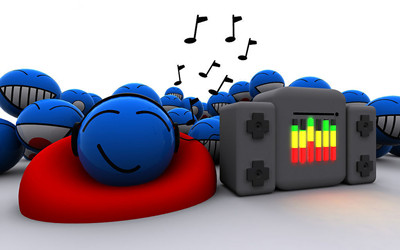(单词翻译:单击)
听力文本
This is Scientific American — 60-Second Science. I’m Christopher Intagliata.
Jay Z's "Tidal" platform promises listeners CD-quality streaming music, in all its 44.1 kilohertz, 16 bit glory—much better, they say, than compressed files, like mp3s. But why stop there? Neil Young's PonoMusic Store sells music that's even better than CD quality.
In a YouTube video for the service Young compares mp3 listeners to scuba divers, muddling around the seafloor. "You know you're walking around in the murk and there's big fish down there, that's kind of like listening to an mp3."
CD listeners are underwater, too. The only way to rise to the top, he says, is to dial up sample rate to over four times that of CD: to 192 kilohertz. "When you make it to 192, you actually break through the surface, and you're breathing air. And the feeling is different, it actually is a visceral relief. You feel good."
But… how good? What researchers, record producers, audiophiles, sound engineers, want to know is: "Is CD, compact disc, enough?" Joshua Reiss (RICE), who leads audio engineering research at Queen Mary University of London. "And the arguments seem to be never-ending."

Reiss took a stab at settling the argument with a meta-analysis—a study of studies—on whether people can really perceive better-than-CD quality sound. He analyzed data from 18 studies, including more than 400 participants and nearly 13,000 listening tests. Overall, listeners picked out the better-than-CD-quality track 52.3 percent of the time. Statistically significant, if not all that impressive.
But when Reiss isolated studies that trained listeners first and gave them a chance to feast their ears on the difference, their odds of picking the higher-quality track climbed to 60 percent. Suggesting there may actually be some perceptible difference... at least enough to convince Reiss to change his listening habits. "Yes I think I actually will, based on this." The analysis is in the Journal of the Audio Engineering Society.
Not that it will settle all arguments. "No, no never. But what I think it might do is allow the researchers to move on a little bit from this question and to start looking deeper into the causes of the perception." And for the audiophiles out there? It's no doubt music to their ears.
Thanks for listening Scientific American — 60-Second Science Science. I’m Christopher Intagliata.
参考译文
这里是科学美国人——60秒科学。我是克里斯托弗·因塔利亚塔。
Jay Z的“潮汐”平台承诺为听众提供CD品质的流媒体音乐,44.1千赫,16比特,他们说这比mp3等压缩文件的品质更高。但是为什么要停在这里?尼尔·杨的波诺音乐商店出售的音乐品质甚至比CD品质更高。
杨在上传到优兔网上的视频中,将mp3听众比作漫游在海底的水肺潜水员。“你知道你正在黑暗中漫步,周围有大鱼游来游去,这就像在听mp3。”
CD收听者也在海底。他说,唯一可以升到海面的方法是把采样率调到CD的4倍以上:调至192赫兹。“当你把采样率调至192赫兹时,你就冲破了海面,可以呼吸到空气了。这种感觉很不同,就像发自内心的解脱。你感觉非常好。”
但是,有多好呢?研究人员、唱片制作人、音响发烧友和音响师想知道的是:CD的品质足够吗?约书亚·赖斯在伦敦玛丽女王大学主导了一项音频工程研究。“争论似乎永远不会停止。”
赖斯试图用整合分析来解决争论,他对人们是否能感知到比CD品质更好的音乐进行了研究。他分析了18项研究中得到的数据,包括400余名参与者和近1300个听力测试。总体来说,收听者辨别出优于CD品质音乐的概率为52.3%。从统计学意义上看,并不是全部都令人印象深刻。
但是当赖斯把研究分离出来,先对收听者进行培训,给他们的耳朵享受不同音乐的机会以后,他们辨别出高品质音乐的机率上升到60%。这表明可能存在显著的差别,至少可以说服赖斯去改变他的收听习惯。“基于此,我认为我会改变我的收听习惯。”这一分析结果刊登在《音频工程学会志》上。
这一研究结果并不能解决所有争论。“永远不会。但是我认为这可能会让研究人员从这个问题转向另一个问题,开始深入研究感知原因。”这对音响发烧友来说意味着什么?毫无疑问,这对他们来说绝对是好消息。
谢谢大家收听科学美国人——60秒科学。我是克里斯托弗·因塔利亚塔。
译文为可可英语翻译,未经授权请勿转载!
重点讲解
重点讲解:
1. break through 冲破;突破;
例句:The sun broke through after days of rain.
下了许多天的雨之后,太阳终于拨云而出。
2. take a stab at 尝试;试图;
例句:He took a stab at forecasting.
他尝试进行预测。
3. pick out 辨认出;分辨出;
例句:The detective-constable picked out the words with difficulty.
探警费力地辨认出这些文字。
4. no doubt 无疑地;必定;
例句:She has no doubt as to the correctness of her own estimate.
她对自己所作估计的正确性确信无疑。
5. music to one's ears 悦耳的声音;佳音;中听的话;
例句:Popular support—it's music to the ears of any politician.
大众的支持对任何一名政界人士来说都是佳音。


